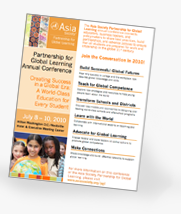Global Competence
The concept of global competence has emerged as a way of articulating the knowledge and capacities students need in the 21st century. What are the elements of global competence?
Disciplinary and Interdisciplinary Knowledge and Understanding The bottom line? Learning content matters, here and everywhere else. Global competence requires knowledge and understanding of seminal content and skills within academic disciplines and the capacity to use disciplinary methods of inquiry creatively and productively. They need to learn to think like historians or scientists or artists. How our “Common Core” standards compare to the curriculum in Brazil, China, Russia or Nigeria matters, too. It is with people from places like these that our students will collaborate and compete.
Global competence also requires the ability to understand prevailing world conditions, issues and trends through discipline-based and interdisciplinary learning. A competitive advantage will go to those students in San Francisco or São Paulo who know what’s going on in the world and how the world works, from climate change to migration trends to human rights. Educating students for global competence requires substantive, developmentally appropriate engagement over time with the world’s complexities.
Gaining this knowledge and understanding depends on acquiring and applying four key cognitive capacities – essential dimensions of global competence. Today’s globally competent youngsters are able to:
Investigate the World
Global competence starts with asking important questions. Globally competent students can frame “researchable” questions – questions that do not necessarily have one right answer, but can be systematically engaged intellectually and emotionally. They ask questions that are globally significant, questions that address important phenomena and events that are relevant world wide – from elementary school students’ inquiries about how to recycle plant debris to fertilize the school garden to high school students’ impassioned debate on how to create sustainable cities in the midst of arid deserts.
Globally competent students can explain how a local issue like their school recycling exemplifies a global process far beyond their back yards. They can articulate the significance of their questions and know how to respond to these questions by identifying, collecting and analyzing credible information from a variety of sources. These sources include international resources in multiple languages available through digital technology. From analysis to synthesis to evaluation, they can weigh and integrate evidence to create a coherent response that takes into consideration geographic, cultural, economic, political, and other contextual factors and provide a compelling, evidence-based argument that considers multiple perspectives and draws defensible conclusions.
Recognize Perspectives
For global competence, the golden rule, “Do unto others as you would have them do unto you” becomes the platinum rule: “Do unto others as they want done unto them.” This seismic shift in perspective – from inward-out to outward-in – has profound implications. Globally competent students recognize that they have a particular perspective that others may or may not share. They are able to articulate and explain the perspectives of other people, groups or schools of thought and identify influences on these perspectives, including how differential access to knowledge, technology and resources can affect people’s views. They can compare and contrast their perspective with others, and integrate their own and others’ viewpoints to construct a new one, when needed.
Communicate Ideas
Globally competent students understand audiences that differ on the basis of culture, geography, faith, ideology, wealth and other factors and that they may perceive different meanings from the same information. They can effectively communicate, verbally and non-verbally, with diverse audiences which requires speaking more than one language. They’re media and artistically savvy as well; they know how to choose and effectively use appropriate technology and media with diverse audiences.
Take Action
What skills and knowledge will it take to go from learning about the world to making a difference in the world? First, it takes seeing oneself as capable of making a difference. Globally competent students see themselves as players, not bystanders. They’re keenly able to recognize opportunities from targeted human rights advocacy to creating the next out-of-the-box, must-have business product we didn’t know we needed. Alone or with others, globally competent students can creatively construct options for action based on evidence and insight, and assess their potential impact, taking into account varied perspectives and potential consequences for others.
Global competence is a crucial upgrade in our understanding of the purpose of education in a changing world. Students everywhere deserve the opportunity to succeed in the global economy and contribute as global citizens. Knowing what knowledge and skills they need to seize that opportunity, and designing schools that help them attain them are essential for students to succeed in the interconnected world of the 21st century.
Discussion
Do the qualities described in this article encompass what students should know and be able to do in a global economy? Please share your perspectives and experiences in the comment board below.


